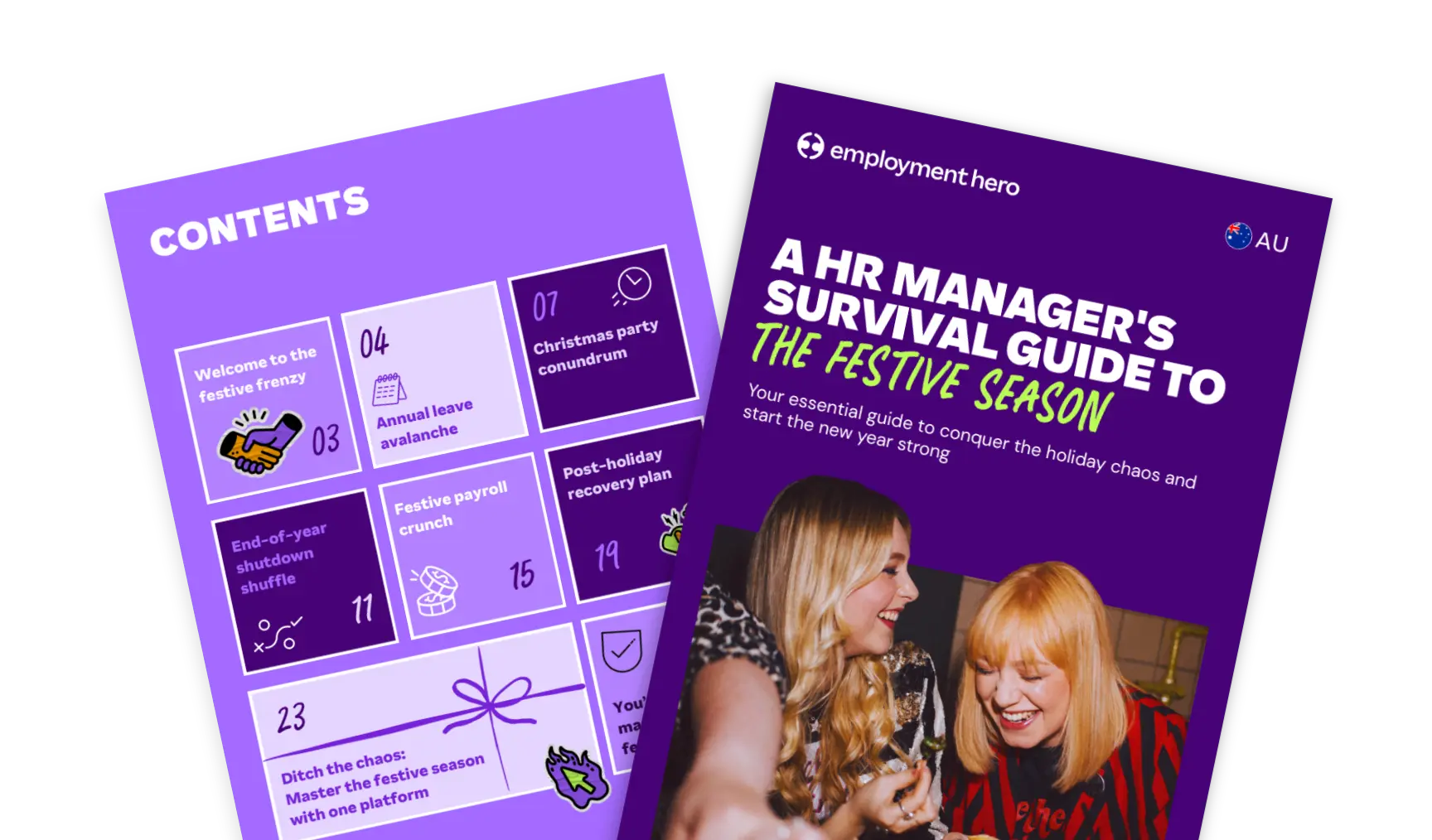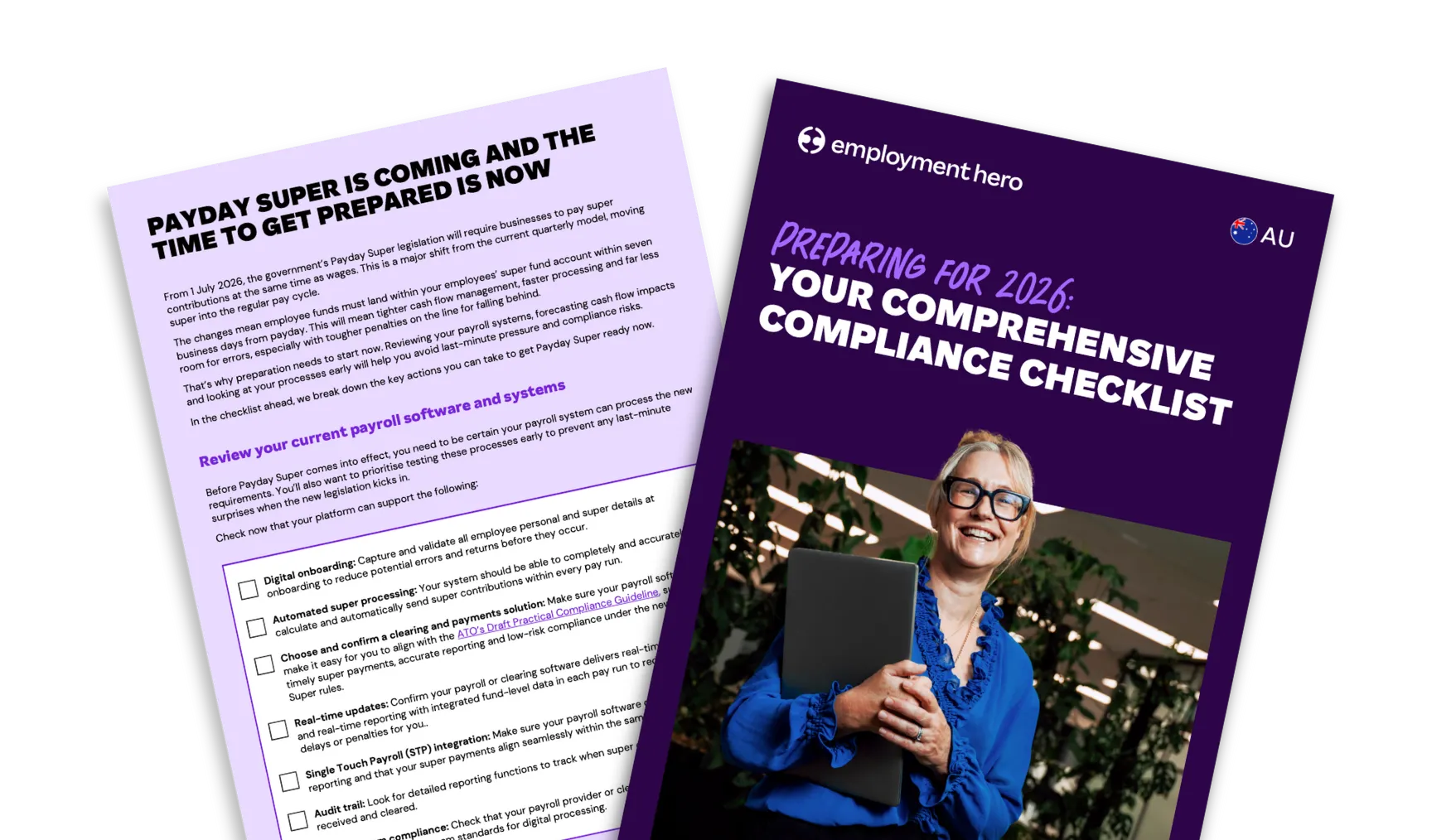Employee engagement scorecard
Published
Employee engagement scorecard
1 min read
Employee engagement is a measure of how well your team members interact with their role, their colleagues and your business as a whole.
Highly engaged employees are more likely to be motivated and committed to their work. This creates a better company culture, which then has the opportunity to improve morale and employee satisfaction.
Our employee engagement scorecard can help you make this a reality. We’ve listed the key things that successful companies do to improve their employee engagement, so you can grade your business’s progress.
Let’s get to it.
How can you use this employee engagement scorecard?
We’d suggest you take some time, make a cuppa and treat the scorecard as an honest audit of your company right now. How many boxes can you check off and what is your final score? It’s a great way to understand where your current strengths lie in employee engagement.
Then, make a plan to address the boxes still unchecked in the coming months. Under each box, we’ve included some helpful hints on how you can bolster your efforts.
Set a date for around 6 months time to test the scorecard again and track any improvements. Good luck!
What is an employee engagement score?
Employee engagement is a broad concept, capturing the feelings that your team have about their work and the way in which they interact with the business. That’s why it can be difficult to analyse, as there aren’t any specific metrics that can grade and measure employee engagement as a whole.
Our scorecard takes a wide-ranging approach, including different initiatives and methods used in companies with great employee engagement. You’ll get a point for each initiative you’re already using in your business, and be able to tally a final score out of 12.
It’s not an exact science, but it’s a good way to check your performance in lots of different aspects of employee engagement at once.
Does high employee engagement always mean higher employee satisfaction?
Generally engaged employees are those that enjoy their roles, feel supported and motivated to do their work. Measuring employee satisfaction and happiness is a useful way to check how any new employment engagement initiatives are faring. However, it is not the only way to measure employee engagement, and should not be the only information you’re relying upon.
To better understand the crucial employee engagement metrics that drive success in managing your workforce, refer to our complete guide to HR metrics

What is a good employee engagement score?
In our scorecard, you’ll of course be aiming for a perfect 12 points! However, most companies won’t reach that 12 points, at least not for their first time using it. Every business will be different.
The most important thing when using this scorecard is that you’re using it as an honest appraisal of your company, and a tool for improvement. Any missed boxes are an opportunity to bring something new to the company.
A good employee engagement score is therefore always one where you’ve improved on a previous score, whether that’s by two points or six.

Factors that can affect your employee engagement score
Our employee engagement scorecard has 12 defining factors that make up a score. The scorecard asks if your company:
- Has clearly defined organisational values
- Has a shared purpose that every employee understands
- Has descriptions for all individual employee roles
- Has set career pathways for each team member
- Offers employee development opportunities
- Ensures a positive work environment
- Maintains clear communication channels
- Regularly solicits feedback from the whole team
- Actively nurtures employee relationships
- Motivates employees with rewards
- Offers a competitive salary and benefits package
- Supports the team’s wellbeing
For more information on each of these points, check out the complete scorecard by filling out the form.

Why is measuring employee engagement important?
Employee engagement is more than just a nice-to-have. If you want a thriving and productive business, you need an engaged team who have everything they need to succeed.
To understand how engaged your team is, you need to measure that in more ways than just looking around the office.
Engaged employees are energised and passionate about their work. These high-performing employees are more willing to go the extra mile, often without being asked, and raise the bar of the service offered by your company.
The benefits of employee engagement work for both employers and employees. Engaged workers will not only be happier and more fulfilled by their job, but feel as though time in the workday passes much quicker. Think of them as someone who is more focused on their work instead of waiting for the clock to allow them to go home.
A team of highly engaged employees can have a direct correlation on your business outcomes. When employees are genuinely invested in their work, it’s likely you see an increase in productivity and efficiency, higher customer satisfaction and customer retention, a reduced employee retention rate, and a more robust, positive work environment.
On the other hand, a poor employee engagement score can trigger a landslide of negative effects – such as decreased customer satisfaction, the delivery of subpar customer service from your team and overall disengagement from your team. A poor employee engagement score serves as a critical warning sign that demands immediate attention.

What is the ideal frequency for measuring engagement?
You can’t improve what you don’t track, which is why establishing the correct cadence to measure employee engagement is essential.
We’d recommend a six-monthly frequency for using this employee engagement scorecard. That’s enough time to implement a few new initiatives or work towards a key area of improvement, but not long enough that it could get forgotten.
For your best chance of success, especially if you work in a busy environment, make sure you pop a date in your calendar for the next scorecard review.

How to put the results from your employee engagement scorecard into action
Once you have a clear understanding of where employee engagement levels are sitting within your team, now comes the critical part: turning those numbers and insights into meaningful action.
Here’s a breakdown of how to leverage your scorecard to drive meaningful change within your business.
1. Analyse and understand your employee engagement scorecard
The first step involves looking at the data and results and thoroughly examining your employee engagement scorecard. This will provide you with a comprehensive understanding of your current engagement levels and potential engagement trends.
2. Prioritise and address key issues based on the engagement data collected
Once you’ve examined the data, identify and prioritise areas for improvement based on your scorecard’s findings. If you have a poor employee engagement score in specific areas, especially those impacting business outcomes, these should go to the top of the list.
3. Gather deeper insights through additional feedback from your team
You’ve got the data from the scorecard, but now it’s time to go a little deeper. Use the scorecard as an opportunity to help form employee engagement surveys, enabling you to gather valuable employee feedback and further understand the “why” behind the numbers.
A spotlight on employee engagement surveys
Employee engagement surveys are vital tools for understanding employee sentiment. They provide quantifiable data on job satisfaction, loyalty, and overall engagement levels. Typically, they are regular engagement surveys that are conducted anonymously, and help promote honest feedback and reveal engagement trends.
Key questions should focus on engagement drivers like career opportunities and development, recognition within the workplace, and work-life balance. Analysing the results allows you to identify areas needing improvement and develop targeted engagement initiatives.
Plus, it’s just another way you can create actionable insights and track how your efforts impact engagement scores, helping you build a more positive work environment, and enhance employee engagement in the process.
4. Develop and implement targeted employee engagement strategies
You’ve got your insights, now it’s time to put strategies in place. To create an employee engagement strategy, you need to make specific, measurable goals based on your analysis.
The goal of the strategies should be to address key issues from the results, like low job satisfaction, lack of career growth opportunities, or inadequate professional development.
By implementing new processes based on employee feedback, you’ll send a message that you’re taking change seriously, and that you’re actively listening to employee concerns.
Need some ideas to boost employee engagement? Here’s what your employee engagement strategies could look like.
- Introducing regular town-hall or all-hands meetings to share wins and align on company goals
- Creating an internal newsletter
- Creating a culture of 1:1s and feedback
- Introducing a mentorship program
- Putting in set plans for career development and paths
- Putting in new plans to support flexible working arrangements
- Offering volunteer opportunities to promote community involvement
5. Monitor, evaluate, and aim to continuously improve your employee engagement score over time
Putting in strategies to enhance employee engagement isn’t a set and forget – it’s something you need to check-in on regularly.
As an employer, you should regularly calculate employee engagement scores, track engagement levels, and use engagement surveys to monitor the effectiveness of your initiatives. Once you have all this data, you can implement strategies or refine existing ones to boost morale and engagement in your team.

Download the employee engagement scorecard
Think of employee engagement like a garden – some areas are blooming, yet others need a bit of TLC. Maybe you need to boost opportunities for career development and upskilling, or maybe your current processes for internal communication aren’t super clear.
Whatever the results provide, use this as your roadmap to a better workplace and start digging into those scores; afterall, they’re telling you something. If there’s a dip in one area, figure out why.
It’s important to note that achieving great engagement levels cannot be done by one process. As our scorecard shows, it requires a mix of communication channels, defining purpose, collaboration, and learning.
Whatever it is bringing your employee engagement score down, use this as a sign to make a plan, and get everyone involved. And lastly, don’t set and forget. You have to actively keep checking in, listening, and adjusting to create a team of highly engaged employees.
Remember, a happy, engaged and loyal team is your competitive edge, and it has all the power to make a difference to your bottom line.
Take this opportunity to transform your culture, support your employees and build a fantastic workplace. Download our employee engagement scorecard now.
For more support in improving employee engagement, find out how Employment Hero’s specialised software can make a difference

Using software to boost employee engagement
Creating an engaging workplace with high employee satisfaction and job satisfaction is no easy feat. Thankfully, all of this can be made easier with our employee engagement software.
Employment Hero can help simplify your process and offer measurable ways to track the levels of employee engagement in your company all through one streamlined experience.
Some of the advantages of using our employee engagement platform (on top of creating a team of highly engaged employees) include:
- An employee self-service portal where employees can request leave, view payslips and update their details easily, building trust and heightening employee engagement.
- The Employment Hero Work mobile app where employees can manage leave and timesheets or find contact details on the go.
- The Company Feed is a reward and recognition tool where members of your organisation can publicly thank each other and show their appreciation, helping employees feel engaged with the entire organisation.
- Custom Surveys where you can create and send Custom Surveys to employees to collate, track and analyse feedback, comparing it with your business outcomes.
- Happiness scores provides insights via an anonymous, monthly score that gauge the vibe of your business
- Peer to peer feedback through which staff can recognise the efforts of one enough to establish greater camaraderie and performance
Learn more about how we can help with employee engagement strategies by booking a demo with our business specialist today.
Looking for more valuable resources to boost employee engagement and support your team?
Register for the scorecard
Related Resources
-
 Read more: HR Managers: Don’t just survive the festive season, master it
Read more: HR Managers: Don’t just survive the festive season, master itHR Managers: Don’t just survive the festive season, master it
Make year-end easier: manage leave, payroll, parties and shutdowns with confidence. Get practical tips for Australian SMEs. Download the free…
-
 Read more: Preparing for 2026: Your Compliance Checklist
Read more: Preparing for 2026: Your Compliance ChecklistPreparing for 2026: Your Compliance Checklist
Get your business ready for the 1 July 2026 changes. See practical steps for Payday Super, cash flow planning and…
-
 Read more: Monthly business budget template for employers
Read more: Monthly business budget template for employersMonthly business budget template for employers
Plan your monthly income and expenses with our free monthly business budget template. Download today to track cash flow and…























